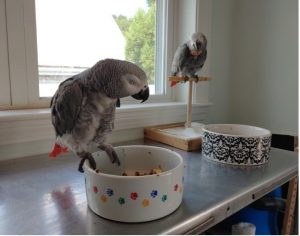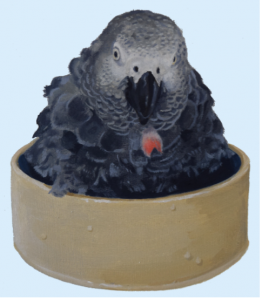
I’ve discussed personality differences in parrots to some extent in previous entries but think that it is an important enough topic to revisit in some depth. To be perfectly clear, each bird has his or her specific personality. Like humans, some birds share certain traits and differ in others, but the combinations of all these traits are unique to an individual.
For example, all my birds have had somewhat different food preferences. Grapes are a constant favorite, but Alex would eat only purple ones…to the extent that he would throw a green one at a trainer and state, “Want grape—purple!” The other birds will eat both. For Griffin, bananas are acceptable only at a particular stage of ripeness. Griffin hates carrots in any shape or form, and (probably having learned from Alex) will throw the offending vegetable at any student hapless enough to put it in his bowl. He never much liked yam until he watched Athena gobble it down, and then warm yam became a favorite…but forget it when it gets cold.
Observational learning goes just so far, however. Athena adores Swiss chard and we bring it in whenever it is available. Griffin watches her enjoy eating this healthy green and consistently asks for it…but each time he takes a bite, he spits it out and shakes his head in what looks like disgust! We actually keep lists so as not to waste food—no sense in putting something in a bowl that will just be ignored or tossed.
Our birds also have serious differences when it comes to toys. Alex would chew on pretty much anything, as does Athena—but for Griffin, the only material that is worth shredding is paper. Griffin ignores just about any toy we put in his cage, as did Alex—but not Athena. She particularly loves her foraging toy and will preferentially forage for the same pasta that is available in a food bowl. That behavior actually inspired a student’s MA thesis—I’ll write about it once the paper is published.

Some of my birds have loved being showered—Alex would keep saying “Want shower!” until he was completely soaking wet. Athena and Griffin tolerate being showered; they both much prefer to try to take baths in their (quite large, but not quite adequate) water bowls—and both will totally ignore the presence of a more suitable container. Another bird, Kyaaro (who was in the lab only briefly, as he had ADHD and wasn’t really a suitable research subject) would bathe only if we gave him a partially water-filled plastic box (the size normally used for cat litter).
From Stranger Danger to Like at First Sight
As I mentioned in an earlier entry, they all react differently to strangers. Alex, for some reason, adored tall blond men. One theory is that he was hand-fed by someone who looked like that before I purchased him; whatever the reason, it was a clear preference. I’d hire a tall blond male student at the same time as a shorter dark-haired female (someone who even looked a bit like me), and the guy would have Alex climbing and trying to regurgitate in minutes, whereas the female would take days to earn his trust.
Griffin is wary of all strangers but does respond fairly quickly to my colleagues who have lots of experience working with nonhumans (folks who know not to stare at him immediately, to spend time talking with me first so that he sees my reaction to them as ‘safe’, and who can judge by his actions when he is ready to interact). Athena in contrast, hasn’t yet met a human whom she doesn’t like—although that doesn’t mean she won’t ignore or nip a trainer who wants her to do something SHE doesn’t find appealing at the moment.
Different Approaches for Different Birds
These personality differences also mean that we must approach training and testing somewhat differently for the different birds. Moreover, it also means that we often get different results for the different birds—and find that such individual differences might be really important when analyzing our data. My colleagues often have the same experience: Sometimes they will not see an overall effect, but then find that a subset of their birds can perform brilliantly while another subset seem to have little ability—or at least little interest—with respect to the task in question. For that reason, we all often claim that if one bird succeeds, the task is within the purview of the species. The argument is much like that for humans—not everyone is an Einstein, a Beethoven, or a Michelangelo—but we claim that humans are capable of brilliance in science, music, and art because of the masterworks of those individuals.
I don’t think that these differences in parrot personality can be attributed to male versus female behavior, given that Athena sometimes matches what Alex would do or like, and at other times matches Griffin. For the same reason, although observational learning likely plays a role in some similarities and differences, it cannot be the entire basis for their behavior patterns. The reasons for personality differences in parrots are likely a combination of the same reasons that exist in humans—an interacting mix of genetics and experiences. The main point is that we need to appreciate these individual differences, accept them, accommodate them, and not assume a ‘one size fits all’ response to the actions of our avian companions!
